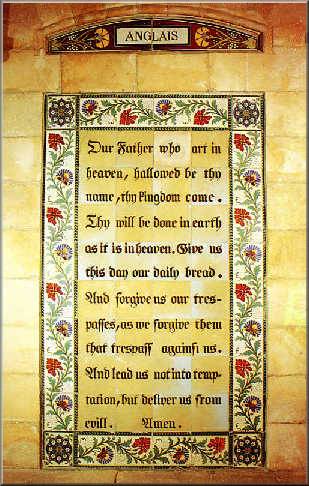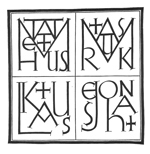
Part Four: |
Lord, Teach Us To Pray |
The Lord’s Prayer
 By every standard of comparison, the most popular prayer in
existence is the Our Father. One sign of its popularity is the number of
polyglot collections of the Lord’s Prayer which have been published at various
times since the invention of printing. Already in 1787 the Spaniard Hervaz
printed the Pater Noster in three hundred
and seven dialects and languages, and the practice of multi-lingual editions
has been going on ever since.
By every standard of comparison, the most popular prayer in
existence is the Our Father. One sign of its popularity is the number of
polyglot collections of the Lord’s Prayer which have been published at various
times since the invention of printing. Already in 1787 the Spaniard Hervaz
printed the Pater Noster in three hundred
and seven dialects and languages, and the practice of multi-lingual editions
has been going on ever since.
But the Lord’s Prayer is not only the most popular prayer in existence, it is also the most important. According to St. Augustine, “whatever else we say when we pray, if we pray as we should, we are only saying what is already contained in the Lord’s Prayer” (Letter 121, 12). The Recitation of the Lord’s Prayer has been woven into the fabric of popular devotion since the days of the catacombs. It forms part of the Divine Office and has been so closely associated with the Sacrifice of the Mass that some have mistakenly thought that without the Pater Noster there would be no valid consecration of the Holy Eucharist. One more reflection: If the Our Father is so popular and so important, is it also the perfect model of what all our prayers should be? Yes. One Father and Doctor of the church after another – Saints Cyprian and Augustine, Teresa of Avila and Robert Bellarmine – did not hesitate to say that the Lord’s Prayer is the divinely revealed pattern of what all Christian prayers should be.
Brevity and ScopeThe brevity of the Our Father is remarkable, because the number of its petitions could hardly be shorter and yet more exalted. The special merit of this brevity is that it can be easily memorized. Since the early days of the Church, those preparing for baptism were expected to recite the Lord’s Prayer by heart. Moreover, we are thereby reminded that there is no need of much talking when we pray. Why not? Because we are speaking to God who knows what we need before we ask Him. What is nore important is the devotion and fervor of spirit with which we pray. The masters of the spiritual life found in the Our Father a proof of the wisdom of Christ, who compressed into a few words all the desires and aspirations of the human heart in its intimate communication with God.
Perfection of the Lord’s PrayerAmong the many saintly commentators on the Lord’s Prayer, St. Thomas Aquinas explains why it must be the most perfect prayer that we can say. The Pater Noster was taught us by Christ Himself. It was also the only prayer He taught us to say. And He gave it to us in answer to the request of His disciples, “Lord, teach us to pray” (Luke 11:1). However, what makes it also commendable is that the structure of the Our Father is perfect. Since prayer is an interpretation of our desires, we should only pray for those things which are proper for us to desire…. Now in the Lord’s Prayer what we are asking for from God is everything that we may lawfully ambition. It is, therefore, not only a catalogue of petitions but also, and especially, a corrective for our affections…. Thus the first object of our desires is our last end; then the means to arrive at this end. But our end is God, to whom our affections incline in two ways: the one in desiring the glory of God, the other in wishing to enjoy this divine glory. The first belongs to charity by which we love God in Himself; the second to charity by which we love ourselves in God. So, the first petition, “Hallowed beThy name,” asks for the glory of God; and the second, “Thy Kingdom come,” asks that we may come to the enjoyment of this glory…. Moreover, we are directed to the end of our existence either by something which is essential or by something which is accidental as a means of salvation. But, it can be essential again either directly, according to the merit by which we deserve beatitude because we are obedient to God, and in this sense we ask: “They will be done on earth as it is in heaven”; or it may be only instrumental, although essential, because it helps us to merit heaven. And in this respect we say: “Give us this day our daily bread,” whether we understand this of the sacramental bread of the Eucharist, the daily use of which is profitable to salvation, or of the bread of the body, which is symbolic for a sufficiency of food…. We are also directed to heaven, accidentally, by the removal of obstacles to beatitude; 1) sin, which directly excludes man from the kingdom of God. Therefore, we pray “Forgive us our trespasses”; 2) temptation, which leads us into sin. Hence our sixth petition, “Lead us not into temptation”; 3) temporal evils, the consequence of sin, which make the burden of life too heavy. Consequently, our final petition, “Deliver us from evil” (Summa Theologica, II, II, 83). Centuries before St. Thomas and ever since, theologians and mystics, exegetes and moralists have written extensively and in depth, explaining the seven petitions of the Lord’s Prayer and applying its lessons to our daily lives.
Words of the Our FatherThere are two versions of the Our Father in the gospels. The longer version is in St. Matthew’s Gospel, where it forms part of Christ’s Sermon on the Mount. The Lord is explaining how we should pray, and warns His disciples not to multiply words, as the Gentiles do. They think that by talking a great deal, they will be heard. Christians are not to pray in this way. Why not? Because God already knows what we need before we ask Him. “In this manner therefore shall you pray:
The foregoing is the text in the Latin Vulgate of the New Testament. Already in apostolic times, the Pater Noster was part of the Eucharistic liturgy, where it was followed by the words, “For thine is the power and the glory, for evermore.” This ending occurs in the first-century liturgical manual, The Teaching of the Twelve Apostles (8:2). It was taken over by the Eastern Liturgy of St. John Chrysostom and may be found in some gospel manuscripts. Since the Second Vatican Council, the liturgical addition called the embolism is part of the Eucharistic Prayer in the Latin Rite. In St. Luke’s Gospel, the Lord’s Prayer occurs as part of the narrative in which the disciples find Jesus praying in a certain place. After He has finished praying, one of the disciples asks Him, “Lord, teach us to pray, even as John also taught his disciples.” He told them, “When you pray, say:
The Church has adopted St. Matthew’s text for the liturgy and for its daily use by the faithful.  Copyright © 2002 Inter Mirifica
Pocket Catholic Catechism |